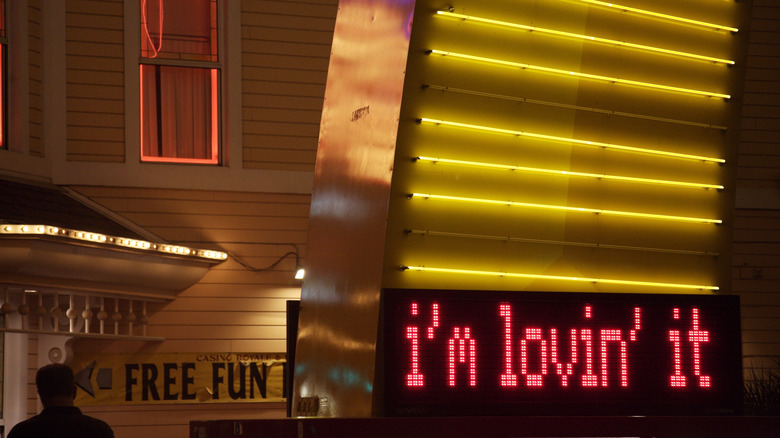This Popular McDonald's Slogan Didn't Actually Start In The US
A simple five-note jingle and a little help from Justin Timberlake is all it took for the world to start loving it. McDonald's has had its fair share of catchy campaigns over the years, including a jingle sung by the guy who wrote "I'd Like to Buy the World a Coke", but none quite matched the simple yet powerful charm of "I'm Lovin' It." Like many great things, the jingle that came out of desperation — from a fast food giant struggling with dropping sales and a likely bleak future. McDonald's needed a miracle, and it came in the form of these three words that went on to become one of the most famous food slogans of all time.
The 2003 campaign became the longest-running in the fast food juggernaut's history. While Timberlake deserves credit for making the now-iconic "ba-da-ba-ba-bah" jingle instantly recognizable (and earning a cool $6 million in the process), few realize the slogan didn't even originate in the U.S. It was birthed in Munich, Germany, as "Ich Liebe Es" (German for I love it), and was the first time the fast food giant rolled out a global advertising them.
Not everyone believed in I'm Lovin' It
The Golden Arches were looking for a phrase that would resonate with customers across cultures; something simple, universal, and emotionally sticky. McDonald's tapped 13 marketing agencies to crack the code, and Germany-based Heye & Partner ultimately hit the sweet spot with "Ich Liebe Es". But finalizing the slogan only marked the beginning. McDonald's knew it had found something special, but it needed an equally memorable jingle to go with these words. Heye & Partner approached music production firm Mona Davis to turn the concept into an English-language tune. According to Adweek, the president of Mona Davis, Tom Batoy, recalled overhearing a backup vocalist casually humming the now-famous "ba-da-ba-ba-bah" during a studio session, and he couldn't get it out of his head. That spontaneous hum would eventually become the most recognizable five-note hook in fast food history, playing in over 120 countries and 20 languages. But initially, not everyone was convinced it would work.
Though the jingle became one of the brand's most memorable assets in terms of recall value, besides the golden arches and McDonald's characters like Grimace and Ronald McDonald, its debut was met with skepticism. Despite Micky D's being a dominant force in advertising, many questioned the decision to spend a staggering $1.37 billion on the campaign in its first year alone. The U.S. rollout, fronted by Justin Timberlake, was one part of it. Globally, it marked one of the company's boldest marketing moves at a time when the company was seeing weaker numbers. Some critics even predicted the slogan would flop. But McDonald's was all in, shelving recent efforts, including a theme called "Smile", to fully commit to "I'm Lovin' It."
The jingle wasn't without controversy
The risk paid off quite well, with McDonald's sales skyrocketing and with a 10.5% increase in same-store sales within the first year itself, but "I'm Lovin' It" found itself at the center of a creative tug-of-war more than a decade later. Justin Timberlake may have been the face and voice of the jingle, but many people were involved in the creation. Producer and musician Pharrell Williams, along with his former bandmate Chad Hugo, Tom Batoy, and his business partner Franco Tortora, as well as Andreas Forberger, the creative director at Heye & Partner, are credited by McDonald's as having written the song.
But this statement came under the lens after a key executive claimed that rapper Pusha T co-wrote the jingle. The rapper backed the claim in 2016, saying he was never properly credited for it. McDonald's and its agencies have never officially confirmed Pusha T's involvement as a co-writer. The rapper even dissed McDonald's in an Arby's ad a few years later over the controversy. The artist targeted the McDonald's Filet-O-Fish sandwich, calling it a "square fish" in the video. It's difficult to say if there is some truth in the statement, but it is fascinating how a jingle with three simple words has such a complex origin story. Nonetheless, the world is still loving it to this day.


